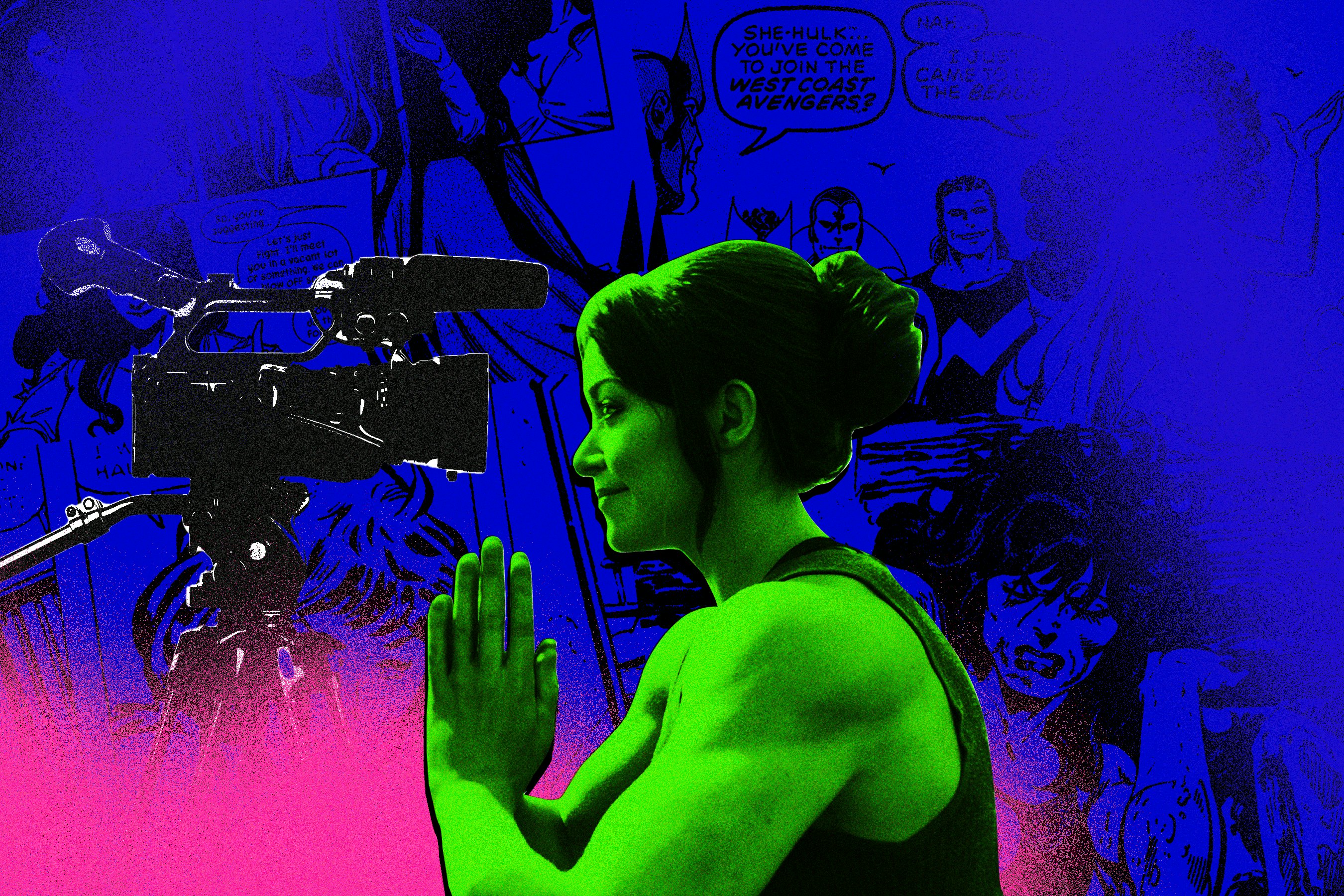
She-Hulk: Attorney at Law begins with a classic superhero trope: a training montage.
After a car crash accidentally infuses Bruce Banner’s (Mark Ruffalo) blood into his cousin Jennifer Walters (Tatiana Maslany), Bruce takes it upon himself to teach her how to be an incredible Hulk — despite her claims that she just wants to live a normal life.
Eventually, Bruce says she can go back to her life as a lawyer if she wants. In response, Jen looks directly into the camera and says, “He doesn’t mean that.” Both Hulks register a moment of shock at Jen’s first fourth-wall break. She-Hulk seems to be discovering a new superpower, while Bruce is both confused and a little annoyed at what she said.
For fans of the comics, She-Hulk’s fourth-wall breaks are less of a surprise. She’s had the ability since as far back 1989’s The Sensational She-Hulk #1, which featured Walters on its cover openly taunting comic shoppers to buy her comic and threatening to rip up their X-Men issues if they don’t.
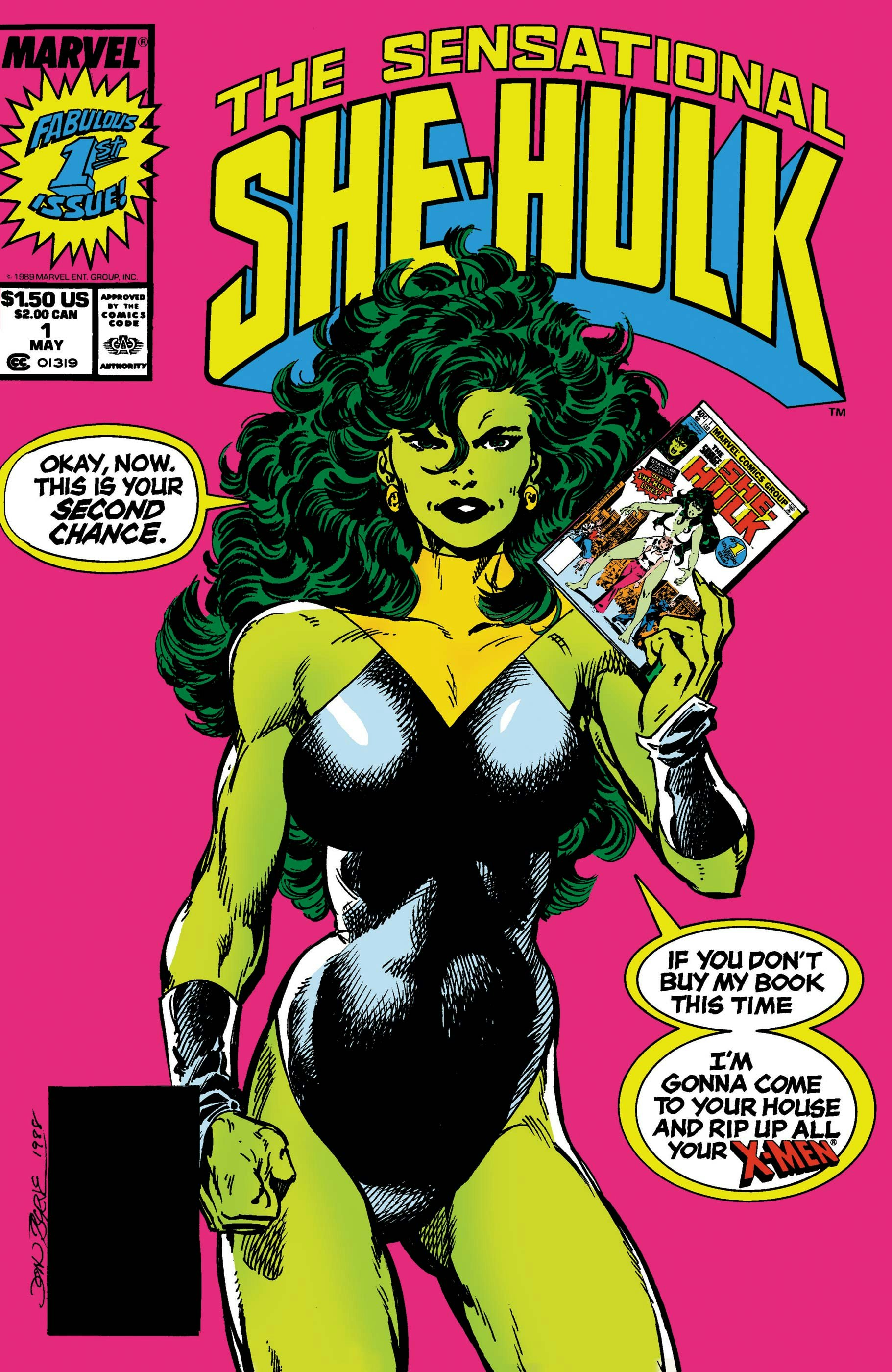
But She-Hulk still marks a major first for the Marvel Cinematic Universe. (Remember, Deadpool’s self-referential antics aren’t technically part of this shared universe yet.) Sure, WandaVision felt self-aware in a way Marvel live-action usually isn’t, thanks to its show-within-a-show format, but Jennifer Walters injects a whole new level of meta self-awareness. And in the process, it could be pushing the carefully calibrated MCU past its breaking point.
Breaking the fourth wall
The term “fourth wall” originated in theater and is a relatively new concept (at least compared to the art form’s 2,500-year history). In ancient and early modern plays, characters spoke to the audience all the time through a technique known as direct address. Go to any Shakespeare performance today and you’ll see characters reveal their true feelings in a soliloquy directly to the audience.
But as that style gave way to realism in the 20th century, there arose a need to define the invisible space between the actors and their audience. Whereas Shakespeare would directly address the audience, new playwrights like Chekhov and Ibsen were portraying everyday events and dramas. Suddenly, there was no need to explain things to the viewer. The fourth wall was born.
“There’s a kind of contract that audience members enter into with the performance. I’m going to sit down and pretend that I’m not sitting on a chair watching people that I may know pretend to be other people,” Anne Stichter tells Inverse. Stichter is the author of the 2016 study The Role of Breaking the Fourth Wall in Audience Ego Identification.

Stichter’s study used two versions of a scene from Shakespeare’s A Midsummer Night’s Dream (one breaking the fourth wall, one not) and then had audiences answer a questionnaire to see how much they empathized with the characters. While the study seemed to confirm a correlation between comfort and empathy for audiences, there was no indication that breaking the fourth wall boosted either. In the process, Stichter also discovered just how under-researched the fourth wall really is.
“Experimental research concerning this topic is virtually non-existent,” she writes.
Going the distance
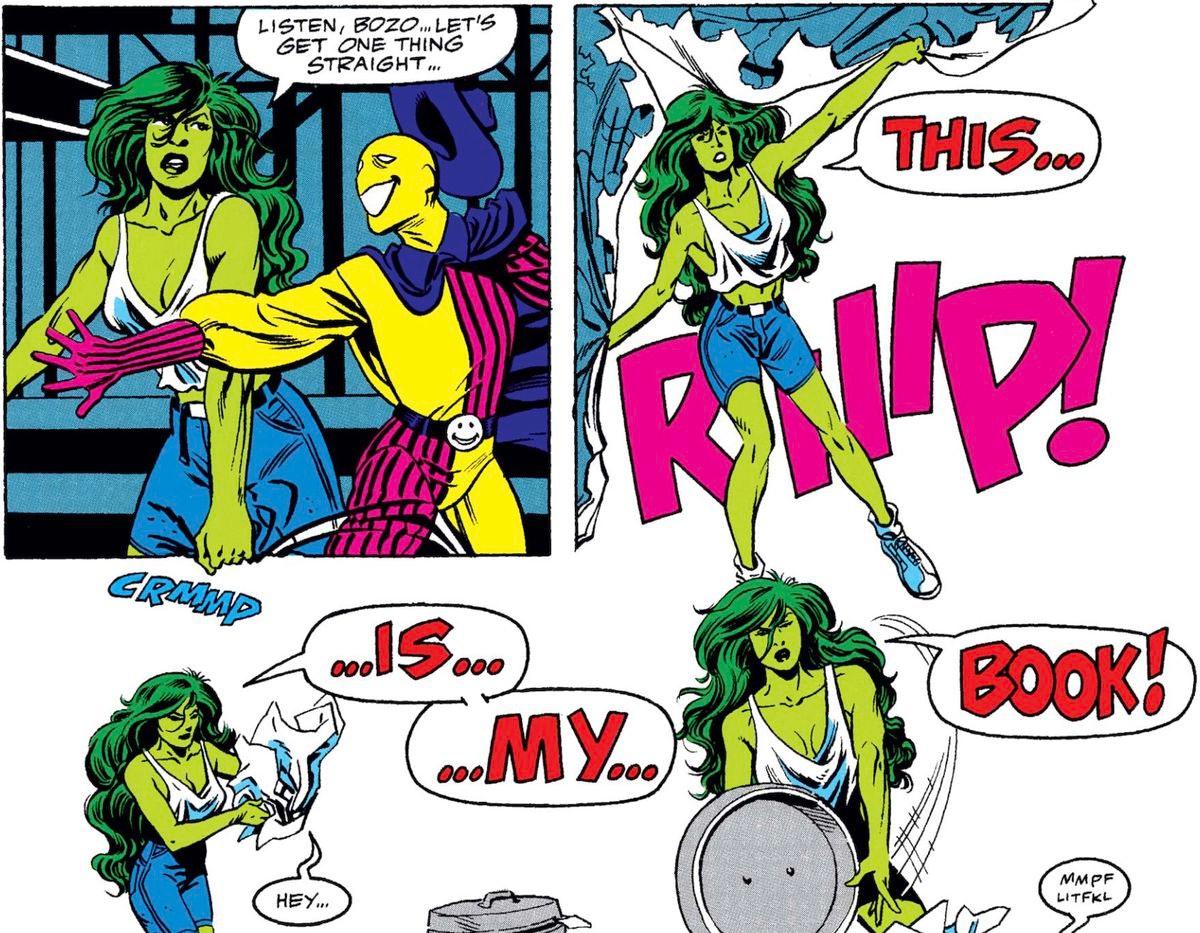
Shakespeare is one thing, but in science fiction, the contract between audience and performance goes even further. When you watch She-Hulk, not only are you signing up to believe Tatiana Maslany is Jennifer Walters, but you’re agreeing to believe she can turn into a giant green lady at will. So when that contract is broken, it can be disarming and even uncomfortable for viewers.
That feeling has a name in psychology: underdistancing.
“Underdistancing is caused by some aspect of the performance seeming too real,” Stichter writes in her study. “It causes the spectator to pull herself out of the illusion, restoring the boundary between fiction and reality.”
Basically, if something you immerse yourself in is too realistic, you’re more likely to pull away.
Fourth-wall breaking is probably the most effective way to underdistance. It reminds the audience of their role and, inadvertently, makes them a part of the action. When Jen talks directly to the audience and refers to us as television viewers, we’re reminded we’re sitting on our couch watching Disney+.
“If it’s happening repeatedly or from the very beginning, that’s the mode everyone’s in,” Stichter says. “So it’s not going to be shocking.”
On the flip side of underdistancing is overdistancing, which is when the world of a story is too out-there to be believable. The Marvel Cinematic Universe as a whole is a great example in how overdistancing can be avoided through human moments to increase empathy — like the Avengers ordering Chinese food takeout while they plan their revenge on Thanos.
The comics (especially those from earlier in Marvel’s history) don’t really have to deal with issues of over- and underdistancing as much because they’re still, hand-drawn images. There’s no psychological question of whether what you’re looking at is real or not. In seeing real humans take those roles, even giant green ones, the characters “come to life” and need to be more relatable.
She-Hulk’s dilemma is that it needs both under- and overdistancing. The result can feel like whiplash. One moment, Jen is promising the audience that her show isn’t going to be a “cameo of the week.” In the next, Wong comes in through a magic portal. Is the vibe ultra-realistic or fantastical?
Smashing the fourth wall
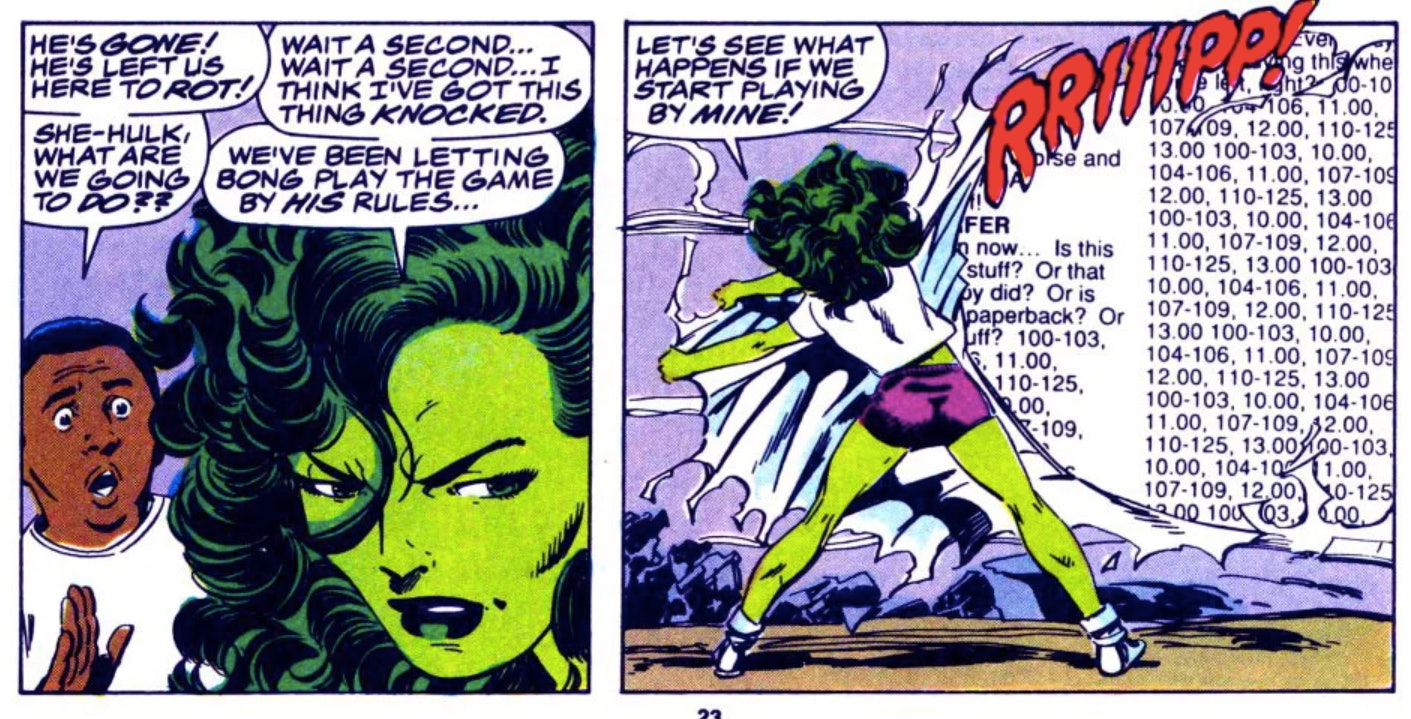
In comics, especially Marvel comics, there’s always been an unwritten rule that the occasional breaking of the fourth wall is necessary for the sake of succinctly getting a reader up to date.
Beyond She-Hulk and Deadpool (two superheroes known for their fourth-wall-breaking), there have even been in-universe explanations for the practice. Rick Jones, known best as the kid Bruce Banner saved from gamma radiation that resulted in him becoming the Hulk, was once endowed with the power of “cosmic awareness,” which made him aware he was in a comic book.
She-Hulk has its own unique approach to fourth-wall breaking. To director Kat Coiro, letting Jen speak directly to the audience was a way to give her more power and agency.
It has to do with being aware of the narrative put upon you, and taking control, Coiro told Inverse in August. “So often in film and media, women are along for the ride. They’re not driving the story. Part of Jennifer Walters’ story is realizing that someone else’s hand is on the wheel, and she wants to control how she gets to where she gets,” the director said.
But is meta self-awareness inherently feminist? One of the most successful fourth-wall-breaking shows is Phoebe Waller-Bridge’s Fleabag, which used the technique to make the audience a sort of confidante to the protagonist’s misdeeds. She-Hulk skirts this line. Sometimes, she speaks to the camera as if defending her actions to a friend. Other times, she’s talking down to Marvel fans and warning them to not get excited about cameos.
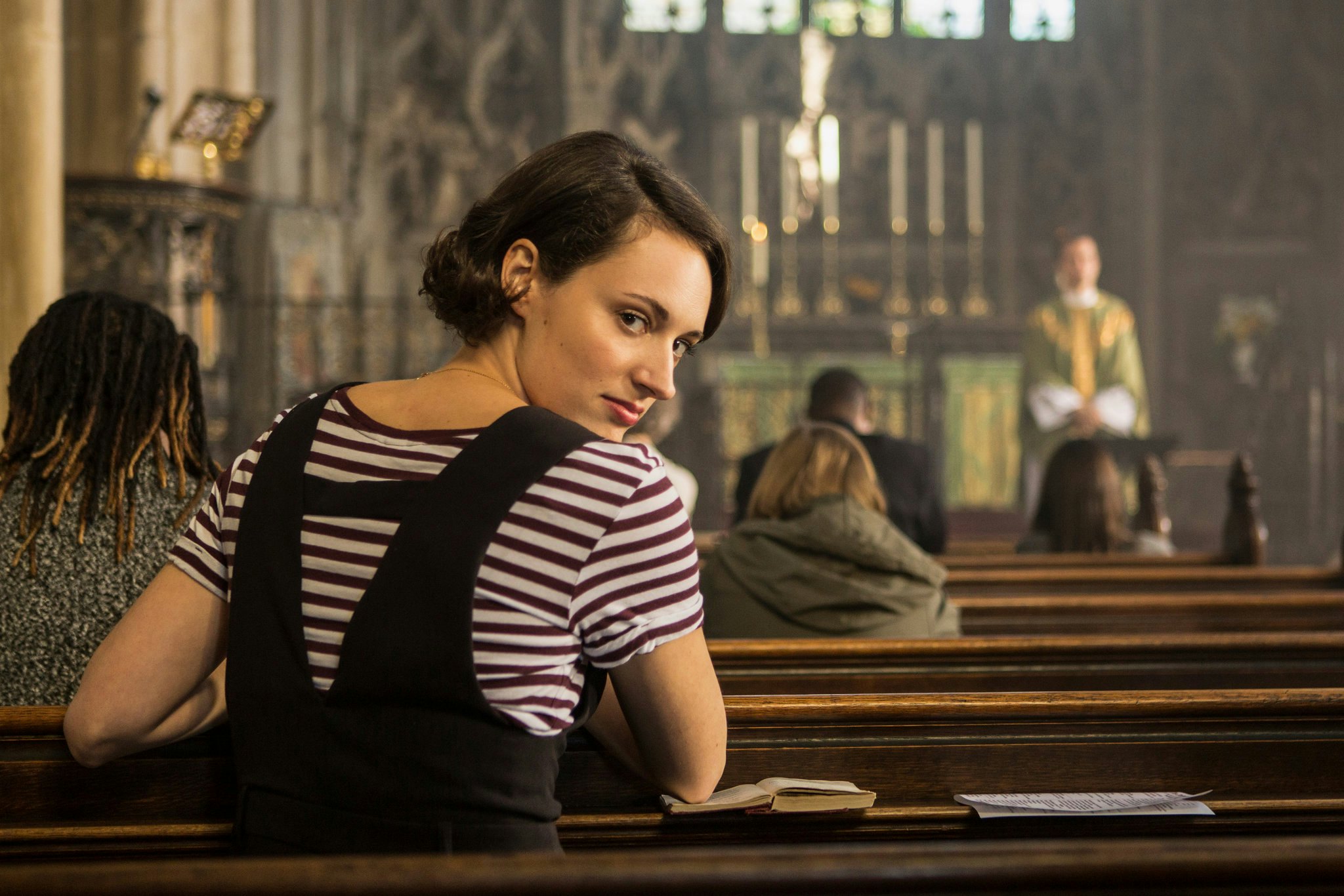
Coiro couldn’t imagine She-Hulk without the fourth-wall breaking that’s defined her since the 1980s, but is this “quintessential” part of her character essential to the series? It brings a new level of intimacy by lowering the psychological “distance,” but ultimately there’s still going to be a disconnect.
Compared to the fourth wall breaks of theater that gave the convention its name, there’s a glaring difference: physical distance.
“It’s like a one-way mirror. Nobody is going to reach out of your TV screen. They can talk to you, but they can’t hear you,” Stichter says. “Comics are the same. They can talk to the audience, but you can’t talk back.”
The same can’t be said for a theater, where the audience can laugh, gasp, and even heckle the actors if so inclined.
Ultimately, She-Hulk is a minor blip in Marvel’s vast machinery, but it might also be an important experiment. If Jennifer Walters’ fourth-wall breaks connect with the audience, we could see a lot more from future shows and movies. If not, this may be one way the live-action Marvel Cinematic Universe fails to capture the spirit of its ink-and-paper source material.
The Inverse SUPERHERO ISSUE challenges the most dominant idea in our culture today.







